engine KIA CADENZA 2020 Owners Manual
[x] Cancel search | Manufacturer: KIA, Model Year: 2020, Model line: CADENZA, Model: KIA CADENZA 2020Pages: 560, PDF Size: 11.37 MB
Page 433 of 560

617
What to do in an emergency
Removing and storing the
spare tire
Turn the tire hold-down wing bolt
counterclockwise.
Store the tire in the reverse order of
removal.
To prevent the spare tire and tools
from “rattling” while the vehicle is in
motion, store them properly.If it is hard to loosen the tire hold-
down wing bolt by hand, you can
loosen it easily using the jack handle.
1. Put the jack handle (1) inside of
the tire hold-down wing bolt.
2. Turn the tire hold-down wing bolt
counterclockwise with the jack
handle.
Use caution when utilizing the sharp
jack handle.
WARNING- Running vehi-
cle on jack
Do not start or run the engine of
the vehicle while the vehicle is
on the jack as this may cause
the vehicle to fall off the jack.
OYG066011
OJFC065035
Page 440 of 560

What to do in an emergency
24 6
Jack label1. Model Name
2. Maximum allowable load
3. When using the jack, set your
parking brake.
4. When using the jack, stop the
engine.
5. Do not get under a vehicle that is
supported by a jack.
6. The designated locations under
the frame
7. When supporting the vehicle, the
base plate of jack must be vertical
under the lifting point.
8. Move the shift lever to the P posi-
tion on vehicles with automatic
transmission.
9. The jack should be used on firm
level ground.
10. Jack manufacturer
11. Production date
12. Representative company and
address
OHYK064001
OHYK064005
OHYK064002
■Example
❈The actual Jack label in the vehicle may differ from the illustration. For
more detailed specifications, refer to the label attached to the jack.
Page 441 of 560
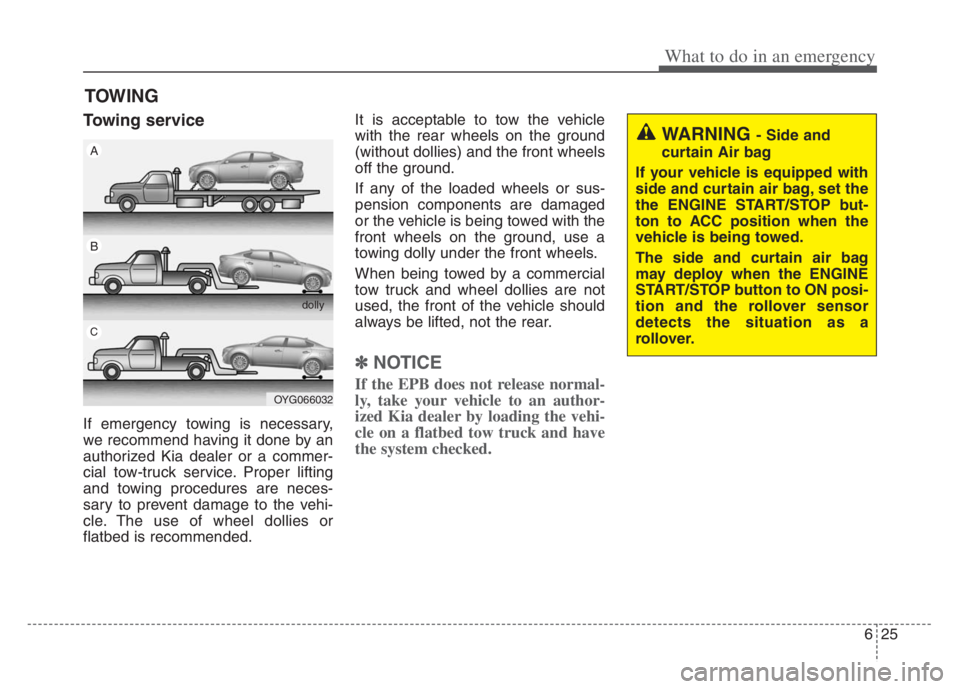
625
What to do in an emergency
TOWING
Towing service
If emergency towing is necessary,
we recommend having it done by an
authorized Kia dealer or a commer-
cial tow-truck service. Proper lifting
and towing procedures are neces-
sary to prevent damage to the vehi-
cle. The use of wheel dollies or
flatbed is recommended.It is acceptable to tow the vehicle
with the rear wheels on the ground
(without dollies) and the front wheels
off the ground.
If any of the loaded wheels or sus-
pension components are damaged
or the vehicle is being towed with the
front wheels on the ground, use a
towing dolly under the front wheels.
When being towed by a commercial
tow truck and wheel dollies are not
used, the front of the vehicle should
always be lifted, not the rear.
✽ ✽
NOTICE
If the EPB does not release normal-
ly, take your vehicle to an author-
ized Kia dealer by loading the vehi-
cle on a flatbed tow truck and have
the system checked.
WARNING - Side and
curtain Air bag
If your vehicle is equipped with
side and curtain air bag, set the
the ENGINE START/STOP but-
ton to ACC position when the
vehicle is being towed.
The side and curtain air bag
may deploy when the ENGINE
START/STOP button to ON posi-
tion and the rollover sensor
detects the situation as a
rollover.
OYG066032
A
B
Cdolly
Page 442 of 560
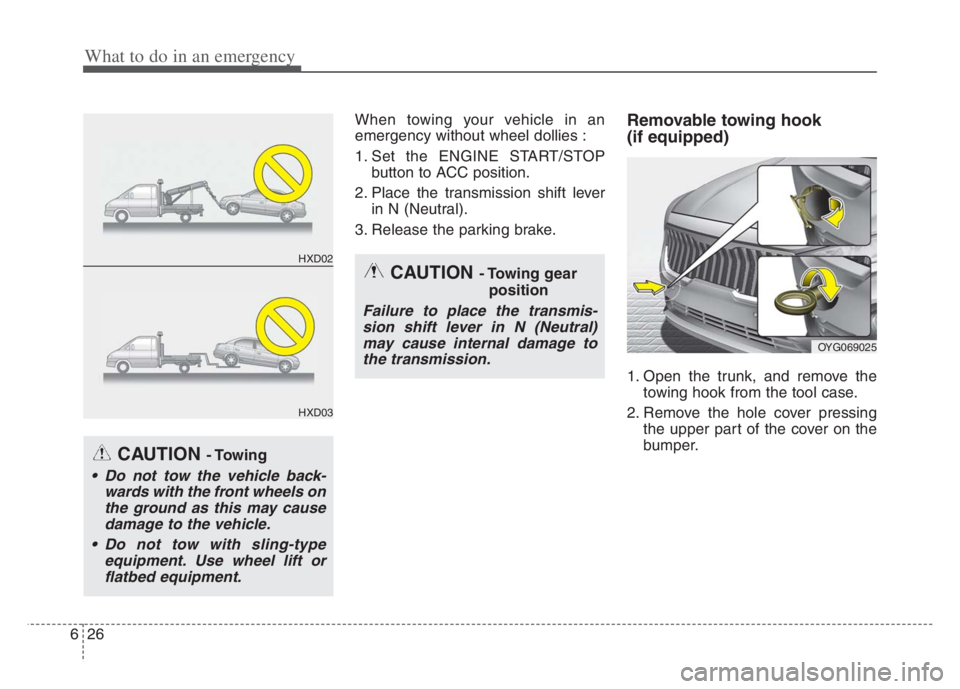
What to do in an emergency
26 6
When towing your vehicle in an
emergency without wheel dollies :
1. Set the ENGINE START/STOP
button to ACC position.
2. Place the transmission shift lever
in N (Neutral).
3. Release the parking brake.Removable towing hook
(if equipped)
1. Open the trunk, and remove the
towing hook from the tool case.
2. Remove the hole cover pressing
the upper part of the cover on the
bumper.
CAUTION - Towing gear
position
Failure to place the transmis-
sion shift lever in N (Neutral)
may cause internal damage to
the transmission.
CAUTION - Towing
Do not tow the vehicle back-
wards with the front wheels on
the ground as this may cause
damage to the vehicle.
Do not tow with sling-type
equipment. Use wheel lift or
flatbed equipment.
HXD02
HXD03
OYG069025
Page 445 of 560
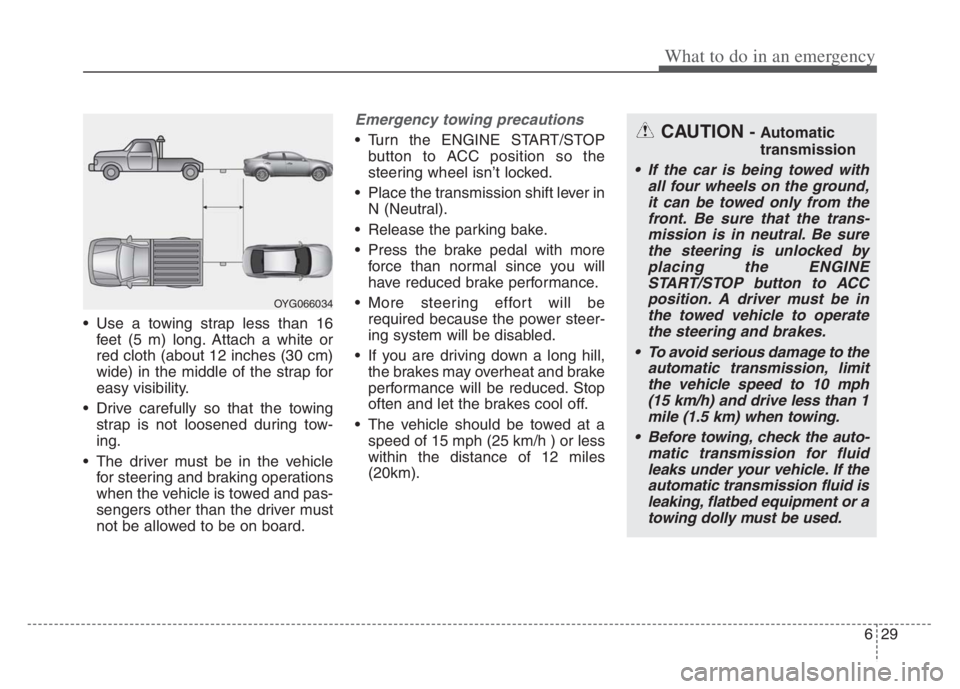
629
What to do in an emergency
Use a towing strap less than 16
feet (5 m) long. Attach a white or
red cloth (about 12 inches (30 cm)
wide) in the middle of the strap for
easy visibility.
Drive carefully so that the towing
strap is not loosened during tow-
ing.
The driver must be in the vehicle
for steering and braking operations
when the vehicle is towed and pas-
sengers other than the driver must
not be allowed to be on board.
Emergency towing precautions
Turn the ENGINE START/STOP
button to ACC position so the
steering wheel isn’t locked.
Place the transmission shift lever in
N (Neutral).
Release the parking bake.
Press the brake pedal with more
force than normal since you will
have reduced brake performance.
More steering effort will be
required because the power steer-
ing system will be disabled.
If you are driving down a long hill,
the brakes may overheat and brake
performance will be reduced. Stop
often and let the brakes cool off.
The vehicle should be towed at a
speed of 15 mph (25 km/h ) or less
within the distance of 12 miles
(20km).CAUTION - Automatic
transmission
If the car is being towed with
all four wheels on the ground,
it can be towed only from the
front. Be sure that the trans-
mission is in neutral. Be sure
the steering is unlocked by
placing the ENGINE
START/STOP button to ACC
position. A driver must be in
the towed vehicle to operate
the steering and brakes.
To avoid serious damage to the
automatic transmission, limit
the vehicle speed to 10 mph
(15 km/h) and drive less than 1
mile (1.5 km) when towing.
Before towing, check the auto-
matic transmission for fluid
leaks under your vehicle. If the
automatic transmission fluid is
leaking, flatbed equipment or a
towing dolly must be used.
OYG066034
Page 446 of 560
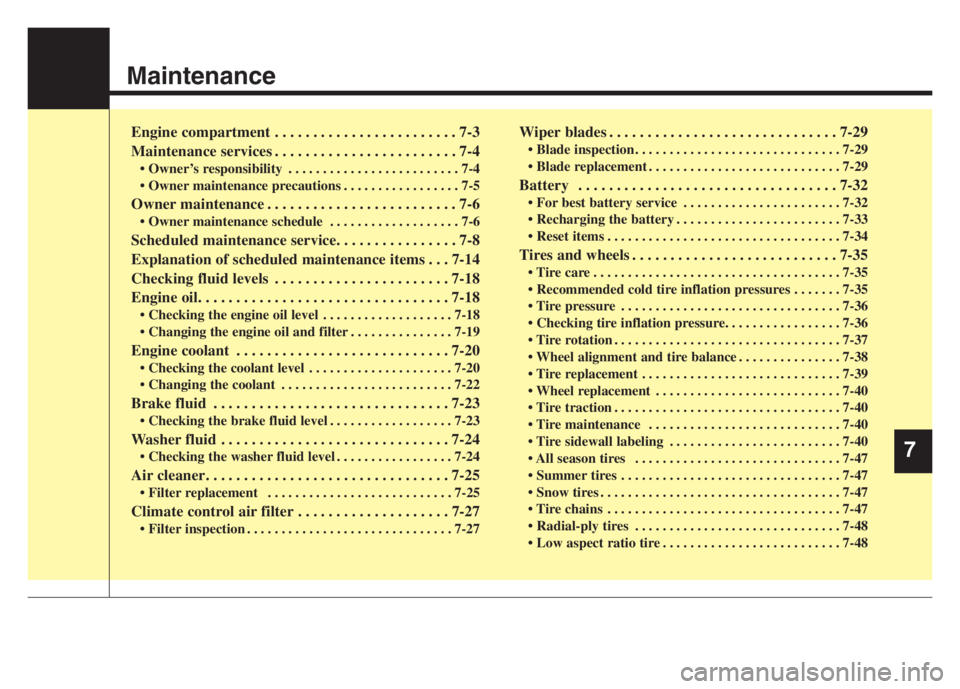
Maintenance
Engine compartment . . . . . . . . . . . . . . . . . . . . . . . . 7-3
Maintenance services . . . . . . . . . . . . . . . . . . . . . . . . 7-4
• Owner’s responsibility . . . . . . . . . . . . . . . . . . . . . . . . . 7-4
• Owner maintenance precautions . . . . . . . . . . . . . . . . . 7-5
Owner maintenance . . . . . . . . . . . . . . . . . . . . . . . . . 7-6
• Owner maintenance schedule . . . . . . . . . . . . . . . . . . . 7-6
Scheduled maintenance service. . . . . . . . . . . . . . . . 7-8
Explanation of scheduled maintenance items . . . 7-14
Checking fluid levels . . . . . . . . . . . . . . . . . . . . . . . 7-18
Engine oil. . . . . . . . . . . . . . . . . . . . . . . . . . . . . . . . . 7-18
• Checking the engine oil level . . . . . . . . . . . . . . . . . . . 7-18
• Changing the engine oil and filter . . . . . . . . . . . . . . . 7-19
Engine coolant . . . . . . . . . . . . . . . . . . . . . . . . . . . . 7-20
• Checking the coolant level . . . . . . . . . . . . . . . . . . . . . 7-20
• Changing the coolant . . . . . . . . . . . . . . . . . . . . . . . . . 7-22
Brake fluid . . . . . . . . . . . . . . . . . . . . . . . . . . . . . . . 7-23
• Checking the brake fluid level . . . . . . . . . . . . . . . . . . 7-23
Washer fluid . . . . . . . . . . . . . . . . . . . . . . . . . . . . . . 7-24
• Checking the washer fluid level . . . . . . . . . . . . . . . . . 7-24
Air cleaner. . . . . . . . . . . . . . . . . . . . . . . . . . . . . . . . 7-25
• Filter replacement . . . . . . . . . . . . . . . . . . . . . . . . . . . 7-25
Climate control air filter . . . . . . . . . . . . . . . . . . . . 7-27
• Filter inspection . . . . . . . . . . . . . . . . . . . . . . . . . . . . . . 7-27
Wiper blades . . . . . . . . . . . . . . . . . . . . . . . . . . . . . . 7-29
• Blade inspection . . . . . . . . . . . . . . . . . . . . . . . . . . . . . . 7-29
• Blade replacement . . . . . . . . . . . . . . . . . . . . . . . . . . . . 7-29
Battery . . . . . . . . . . . . . . . . . . . . . . . . . . . . . . . . . . 7-32
• For best battery service . . . . . . . . . . . . . . . . . . . . . . . 7-32
• Recharging the battery . . . . . . . . . . . . . . . . . . . . . . . . 7-33
• Reset items . . . . . . . . . . . . . . . . . . . . . . . . . . . . . . . . . . 7-34
Tires and wheels . . . . . . . . . . . . . . . . . . . . . . . . . . . 7-35
• Tire care . . . . . . . . . . . . . . . . . . . . . . . . . . . . . . . . . . . . 7-35
• Recommended cold tire inflation pressures . . . . . . . 7-35
• Tire pressure . . . . . . . . . . . . . . . . . . . . . . . . . . . . . . . . 7-36
• Checking tire inflation pressure. . . . . . . . . . . . . . . . . 7-36
• Tire rotation . . . . . . . . . . . . . . . . . . . . . . . . . . . . . . . . . 7-37
• Wheel alignment and tire balance . . . . . . . . . . . . . . . 7-38
• Tire replacement . . . . . . . . . . . . . . . . . . . . . . . . . . . . . 7-39
• Wheel replacement . . . . . . . . . . . . . . . . . . . . . . . . . . . 7-40
• Tire traction . . . . . . . . . . . . . . . . . . . . . . . . . . . . . . . . . 7-40
• Tire maintenance . . . . . . . . . . . . . . . . . . . . . . . . . . . . 7-40
• Tire sidewall labeling . . . . . . . . . . . . . . . . . . . . . . . . . 7-40
• All season tires . . . . . . . . . . . . . . . . . . . . . . . . . . . . . . 7-47
• Summer tires . . . . . . . . . . . . . . . . . . . . . . . . . . . . . . . . 7-47
• Snow tires . . . . . . . . . . . . . . . . . . . . . . . . . . . . . . . . . . . 7-47
• Tire chains . . . . . . . . . . . . . . . . . . . . . . . . . . . . . . . . . . 7-47
• Radial-ply tires . . . . . . . . . . . . . . . . . . . . . . . . . . . . . . 7-48
• Low aspect ratio tire . . . . . . . . . . . . . . . . . . . . . . . . . . 7-48
7
Page 447 of 560
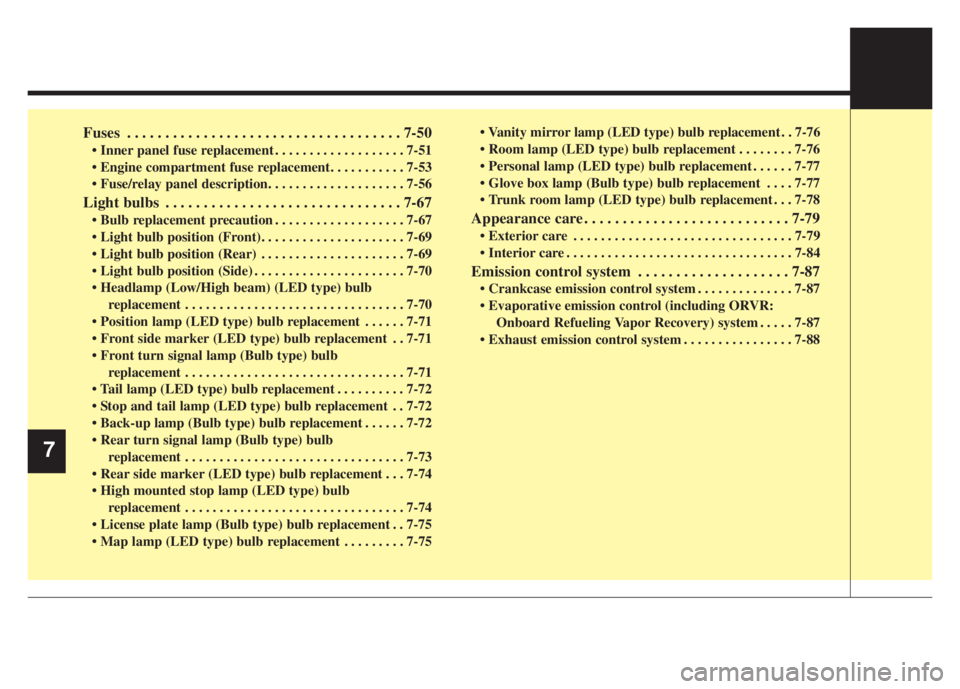
Fuses . . . . . . . . . . . . . . . . . . . . . . . . . . . . . . . . . . . . 7-50
• Inner panel fuse replacement . . . . . . . . . . . . . . . . . . . 7-51
• Engine compartment fuse replacement. . . . . . . . . . . 7-53
• Fuse/relay panel description. . . . . . . . . . . . . . . . . . . . 7-56
Light bulbs . . . . . . . . . . . . . . . . . . . . . . . . . . . . . . . 7-67
• Bulb replacement precaution . . . . . . . . . . . . . . . . . . . 7-67
• Light bulb position (Front). . . . . . . . . . . . . . . . . . . . . 7-69
• Light bulb position (Rear) . . . . . . . . . . . . . . . . . . . . . 7-69
• Light bulb position (Side) . . . . . . . . . . . . . . . . . . . . . . 7-70
• Headlamp (Low/High beam) (LED type) bulb
replacement . . . . . . . . . . . . . . . . . . . . . . . . . . . . . . . . 7-70
• Position lamp (LED type) bulb replacement . . . . . . 7-71
• Front side marker (LED type) bulb replacement . . 7-71
• Front turn signal lamp (Bulb type) bulb
replacement . . . . . . . . . . . . . . . . . . . . . . . . . . . . . . . . 7-71
• Tail lamp (LED type) bulb replacement . . . . . . . . . . 7-72
• Stop and tail lamp (LED type) bulb replacement . . 7-72
• Back-up lamp (Bulb type) bulb replacement . . . . . . 7-72
• Rear turn signal lamp (Bulb type) bulb
replacement . . . . . . . . . . . . . . . . . . . . . . . . . . . . . . . . 7-73
• Rear side marker (LED type) bulb replacement . . . 7-74
• High mounted stop lamp (LED type) bulb
replacement . . . . . . . . . . . . . . . . . . . . . . . . . . . . . . . . 7-74
• License plate lamp (Bulb type) bulb replacement . . 7-75
• Map lamp (LED type) bulb replacement . . . . . . . . . 7-75• Vanity mirror lamp (LED type) bulb replacement . . 7-76
• Room lamp (LED type) bulb replacement . . . . . . . . 7-76
• Personal lamp (LED type) bulb replacement . . . . . . 7-77
• Glove box lamp (Bulb type) bulb replacement . . . . 7-77
• Trunk room lamp (LED type) bulb replacement . . . 7-78Appearance care . . . . . . . . . . . . . . . . . . . . . . . . . . . 7-79
• Exterior care . . . . . . . . . . . . . . . . . . . . . . . . . . . . . . . . 7-79
• Interior care . . . . . . . . . . . . . . . . . . . . . . . . . . . . . . . . . 7-84
Emission control system . . . . . . . . . . . . . . . . . . . . 7-87
• Crankcase emission control system . . . . . . . . . . . . . . 7-87
• Evaporative emission control (including ORVR:
Onboard Refueling Vapor Recovery) system . . . . . 7-87
• Exhaust emission control system . . . . . . . . . . . . . . . . 7-88
7
Page 448 of 560
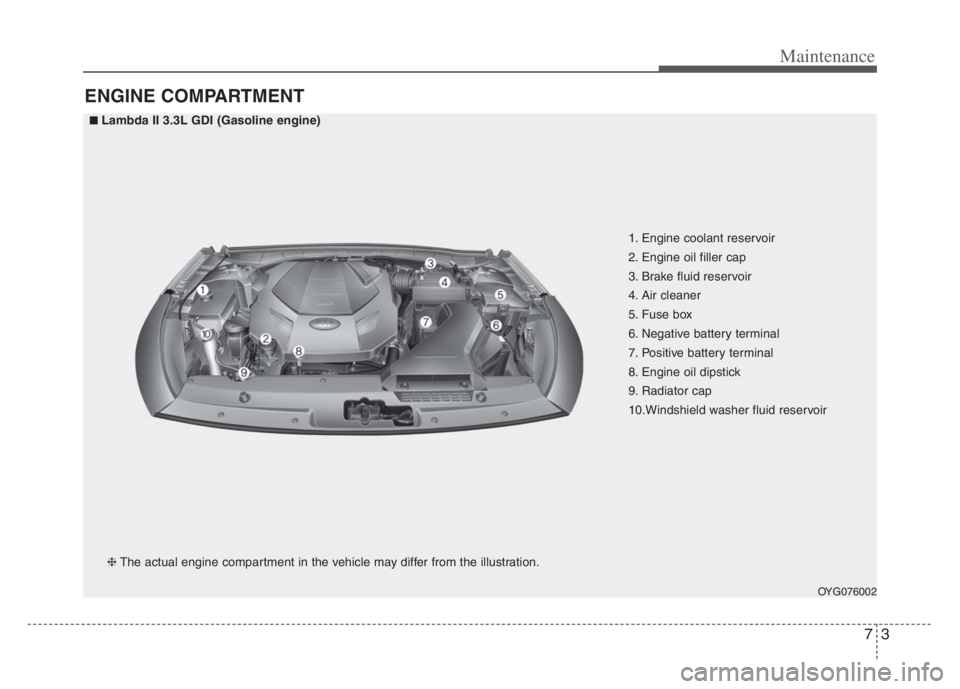
73
Maintenance
ENGINE COMPARTMENT
OYG076002
■ ■Lambda II 3.3L GDI (Gasoline engine)
❈The actual engine compartment in the vehicle may differ from the illustration.1. Engine coolant reservoir
2. Engine oil filler cap
3. Brake fluid reservoir
4. Air cleaner
5. Fuse box
6. Negative battery terminal
7. Positive battery terminal
8. Engine oil dipstick
9. Radiator cap
10.Windshield washer fluid reservoir
Page 450 of 560
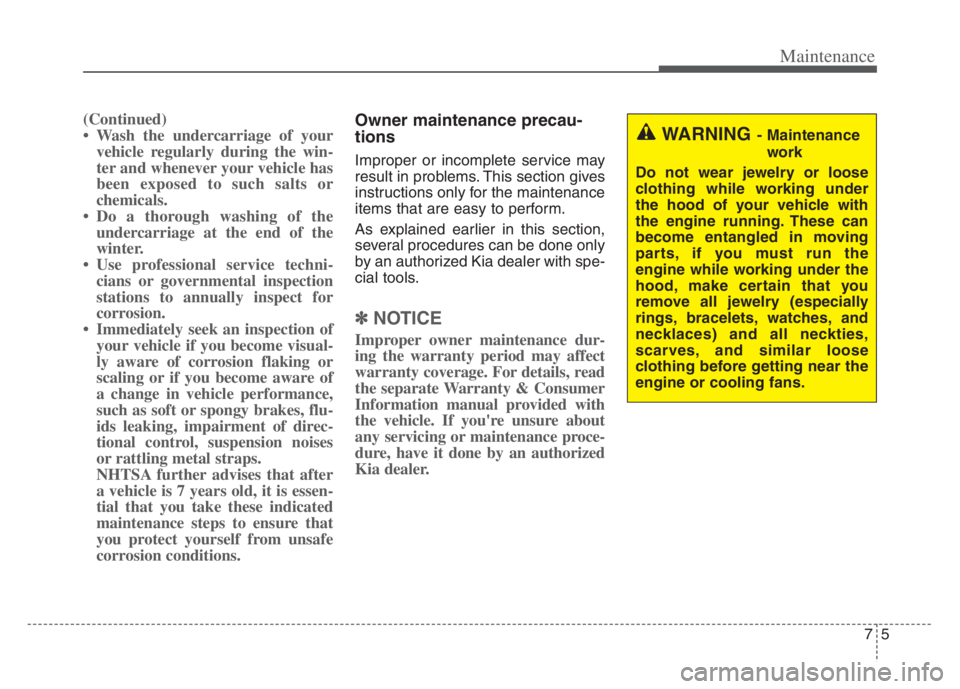
75
Maintenance
(Continued)
• Wash the undercarriage of your
vehicle regularly during the win-
ter and whenever your vehicle has
been exposed to such salts or
chemicals.
• Do a thorough washing of the
undercarriage at the end of the
winter.
• Use professional service techni-
cians or governmental inspection
stations to annually inspect for
corrosion.
• Immediately seek an inspection of
your vehicle if you become visual-
ly aware of corrosion flaking or
scaling or if you become aware of
a change in vehicle performance,
such as soft or spongy brakes, flu-
ids leaking, impairment of direc-
tional control, suspension noises
or rattling metal straps.
NHTSA further advises that after
a vehicle is 7 years old, it is essen-
tial that you take these indicated
maintenance steps to ensure that
you protect yourself from unsafe
corrosion conditions.Owner maintenance precau-
tions
Improper or incomplete service may
result in problems. This section gives
instructions only for the maintenance
items that are easy to perform.
As explained earlier in this section,
several procedures can be done only
by an authorized Kia dealer with spe-
cial tools.
✽ ✽
NOTICE
Improper owner maintenance dur-
ing the warranty period may affect
warranty coverage. For details, read
the separate Warranty & Consumer
Information manual provided with
the vehicle. If you're unsure about
any servicing or maintenance proce-
dure, have it done by an authorized
Kia dealer.
WARNING- Maintenance
work
Do not wear jewelry or loose
clothing while working under
the hood of your vehicle with
the engine running. These can
become entangled in moving
parts, if you must run the
engine while working under the
hood, make certain that you
remove all jewelry (especially
rings, bracelets, watches, and
necklaces) and all neckties,
scarves, and similar loose
clothing before getting near the
engine or cooling fans.
Page 451 of 560
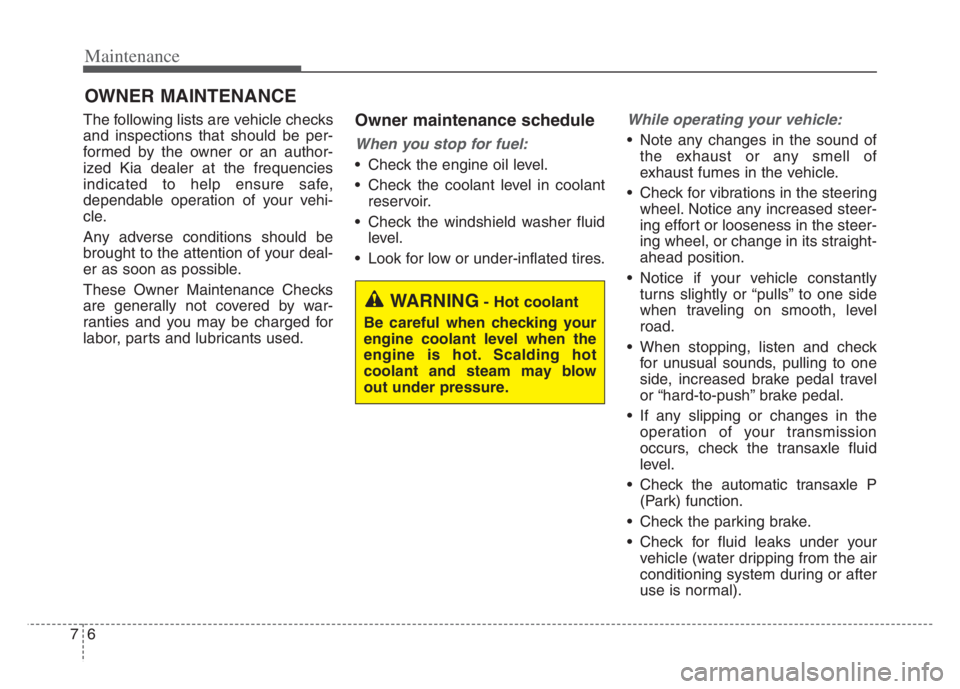
Maintenance
6 7
OWNER MAINTENANCE
The following lists are vehicle checks
and inspections that should be per-
formed by the owner or an author-
ized Kia dealer at the frequencies
indicated to help ensure safe,
dependable operation of your vehi-
cle.
Any adverse conditions should be
brought to the attention of your deal-
er as soon as possible.
These Owner Maintenance Checks
are generally not covered by war-
ranties and you may be charged for
labor, parts and lubricants used.Owner maintenance schedule
When you stop for fuel:
Check the engine oil level.
Check the coolant level in coolant
reservoir.
Check the windshield washer fluid
level.
Look for low or under-inflated tires.
While operating your vehicle:
Note any changes in the sound of
the exhaust or any smell of
exhaust fumes in the vehicle.
Check for vibrations in the steering
wheel. Notice any increased steer-
ing effort or looseness in the steer-
ing wheel, or change in its straight-
ahead position.
Notice if your vehicle constantly
turns slightly or “pulls” to one side
when traveling on smooth, level
road.
When stopping, listen and check
for unusual sounds, pulling to one
side, increased brake pedal travel
or “hard-to-push” brake pedal.
If any slipping or changes in the
operation of your transmission
occurs, check the transaxle fluid
level.
Check the automatic transaxle P
(Park) function.
Check the parking brake.
Check for fluid leaks under your
vehicle (water dripping from the air
conditioning system during or after
use is normal).
WARNING- Hot coolant
Be careful when checking your
engine coolant level when the
engine is hot. Scalding hot
coolant and steam may blow
out under pressure.